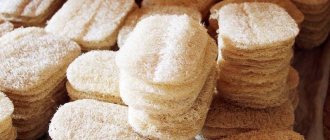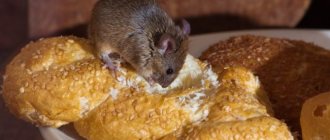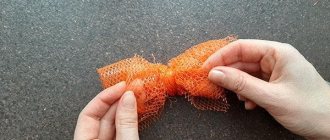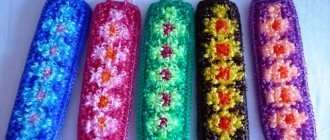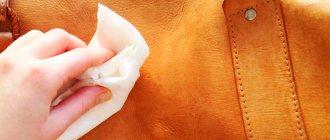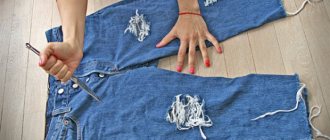Groups Growing exotic plants Vegetables
Enki April 17, 2020 at 3:08 pm3673
Author: Enki
Log in to the site and you can join the group.
Good day!
I’ll tell you about a plant that is still considered exotic, but has the right to occupy a piece of our garden. This is luffa or loofah, I’ve seen it called both.
This plant is interesting for its fruits, which are useful in cooking and farming. For the middle zone and Siberia, most likely, only a greenhouse option with early planting is suitable, but for the south of Russia it is easy to grow in open ground.
Luffa is a herbaceous vine, somewhat similar in leaves and stem to cucumbers, only the fruits are very fibrous when ripe, due to which it has interesting properties. While the fruits are green, they can be eaten. And can be used as eco-scrubbers. I actively use them and now I’ll tell you how to make them.
So, if you need a soft washcloth for the body, then do not let the loofah ripen completely - pick it earlier and dry it under a canopy; the riper it is, the stiffer the fiber. If you need tougher ones, leave the fruits on the bush until they are completely ripe and yellow.
Ripe luffa looks like this:
To make a washcloth out of it, just soak it in boiling water and knead it. Like this:
The dry skin itself will begin to separate easily, exposing the fibers.
I peel it off completely, cut off the ends of the fruit and pour out the seeds. They will also be useful for sowing new loofahs.
We already have a washcloth preparation. I wash it well in soapy water and dry it.
Loofah as a plant
From a botanical point of view, loofah is a representative of the genus of herbaceous vines, which, in turn, are part of the pumpkin plant family. It grows only in warm countries of the world, so it can only be found within Asia and Africa. And since, in addition to high temperature, it also loves humidity, it grows most actively exclusively in regions characterized by a tropical or subtropical climate.
In total, there are more than 50 species of luffa in the world, however, despite some differences between them, almost all plants of this species have similar characteristics. In particular, these include the presence of leaves with five or seven well-defined lobes, which can sometimes be fused together. When the loofah blooms, it produces large white or yellow flowers. Depending on the type of flower - pistillate or staminate - they can be either located singly or collected in inflorescences.
After flowering, a fruit is formed on the trunk of the loofah, which, as it grows, acquires a cylindrical shape and a coarse-fiber structure, and there are a large number of seeds inside the fruit. Loofah is predominantly a wild vine, but some of its species used in the production of products from it are specially bred on farms and in other agricultural institutions.
Using a loofah
The main way to use a loofah today is to make items from it for personal hygiene. In particular, for example, one of the most common products of this kind is a kind of washcloths with a pronounced fibrous structure, which actually represent the processed inside of ripe loofah fruits. Moreover, depending on the nature of the fruit and the method of its processing, the finished product can take a variety of forms.
Such washcloths are very popular among consumers all over the world, as they are a completely natural product. Moreover, during hygiene procedures, such a washcloth provides not only effective removal of dirt, but also a massage of the entire body.
In addition, the young fruits of some species of this plant are suitable for consumption as vegetables. Finally, mature loofah seeds are used to extract oil from them, used for technical purposes, and to make soap.
Throughout my childhood I washed myself with a natural loofah washcloth! The most interesting thing about this is that I had no idea that it was a loofah! Its interesting shape, fibrous, porous structure did not in any way lead me to believe that it was a dried fruit!
Having grown up, I wondered where the raw materials for this natural washcloth come from... My surprise knew no bounds, honestly! So what is a loofah?
In common parlance, it is customary to write the word loofah with one letter f. However, the name is correctly spelled with two letters f, that is, luffa!
Beneficial features
Loofah seeds contain a huge amount of edible oil and protein. Luffa is included in many cosmetic products.
There are also vegetable and technical varieties of this plant. They differ in the quality of the oil obtained and in the scope of its use. Technical varieties are used to prepare loofah, and the oil obtained from the seeds is included in various face masks and other cosmetics. Food grades are used in cooking.
Not only the fruits and seeds of the plant, but also their green part have beneficial properties. For example, the juice from luffa stems in Japan is widely used to create lipstick or used as a lotion to cleanse the skin.
Before World War II, luffa (loofah) was used for industrial production. Due to its light and porous texture, it was used in various filters and diesel parts.
Also, due to good sound insulation and high strength, the fruits of the plant were used as an inner layer in the manufacture of steel helmets and automotive equipment for the US Army.
What is luffa
Luffa is an annual plant from the genus of herbaceous vines. It belongs to the pumpkin family, although in appearance it is very similar to a huge cucumber!
Among the people, luffa received a funny nickname - mad cucumber. The size of the fruit can reach up to 50-70 cm, weight from two to three kilograms, and the vine itself has a length of 3 to 6 meters. When dried, the weight of the fruit decreases significantly.
Luffa prefers tropical and subtropical climates, but it also grows in warm regions. Many amateur summer residents successfully cultivate and grow luffa. The plant is whimsical and has its own “requests”. With proper care, attention and care, as well as good climatic conditions on fertile soil, you can get more than three fruits from one bush!
Fertilizing
You can fertilize the plant using the following substances:
- Ammonium nitrate is used during planting, second and third loosening.
- The mullein solution must be mixed with water in a ratio of 1 to 10. Fertilizing is done during the period of ovary formation.
- Complex fertilizer - you can use 1 tablespoon of nitrophoska diluted in a bucket of water. This procedure is carried out in the middle of the growing season.
- Superphosphate extract - 1 tablespoon of the substance is diluted in a bucket of water. This feeding promotes the ripening of seeds and the best ripening of the fruit.
How to make a loofah from luffa fruit
In order to turn a huge fruit into a wonderful bath attribute, you need to know some subtleties.
Only from ripe fruits can you make a sponge, that is, the pulp inside must dry. The color of the fruit will help you find out the exact time; when it turns brown, the time has come! And, of course, don’t forget about the dry tip at the end.
If the fruits have not had time to ripen (for example, you are unlucky with the weather), then they can be collected green and dried in a warm, dry room.
In order to obtain the skeleton of a loofah without much difficulty, you must first work with the fruit. Some summer residents recommend soaking the luffa skin for several days in water to soften it. But, there is a more practical way:
Dip the dry fruit in boiling water for 10-15 minutes, then cool and the skin is easy to peel. Once you get your future loofah, hold the fibers up to the light. Surprisingly many seeds, right!?
You also need to get rid of the seeds; this can be done in two ways - picking them out or putting a washcloth in water. The seeds should come out of the fibers on their own.
Once you have a real luffa sponge in your hands, rinse it in a soapy solution, then in clean water and let it dry in free air. Now it's time for your imagination! You can cover the luffa with soft fabric, cut it into convenient pieces, make double-sided washcloths - in general, whatever you want!
Transplantation into open ground
After the issue with the location has been resolved, it is necessary to plant the plants themselves. If the luffa is placed in a greenhouse, then the optimal time will be the second half of May, and if open ground is chosen as a permanent place of growth, then all work should be postponed until the beginning of June.
Before planting, you need to prepare holes, the depth and width of which will be 30 centimeters. The distance between plants should be at least one meter.
In order for the luffa (loofah) to take root as best as possible in a new place, the soil must be fertilized:
- You need to pour half a bucket of humus into the bottom and add 2 tablespoons of potassium sulfate there.
- Or you can use half a glass of ash per plant.
The luffa needs to be deepened to the cotyledon leaves, then the roots are carefully dug in; it is very important not to damage them during planting.
How does a luffa washcloth work on your skin?
Any natural washcloth is hard and luffa is no exception to this rule. The fiber dried, hardened and became a rigid material. Not sissies like to wash themselves with such a washcloth. Who wants to enjoy an excellent skin massage in addition to washing - this washcloth is just for you!
An excellent massage effect, deep cleansing of pores, natural peeling of the skin and maintaining its tone - this is what a loofah can offer you. Although this washcloth is particularly hard, it has a softer effect on steamed skin in a bath.
After washing, the skin becomes elastic and toned. When it comes to preventing the formation of cellulite, a loofah made from luffa ranks first!
Crocheted washcloth with elongated loops, the work of our readers
Our master classes and video lessons will tell you how to crochet a washcloth.
Crocheting washcloths, master class!
The author of the description is Noskova Nadezhda. Nadezhda writes that knitting is her hobby! Today she will tell you how to crochet a washcloth.
Crochet washcloth, step by step description
First we knit 40-45 chain stitches and connect them into a circle.
We tie 5 rows with single crochets, then begin to pull out the loops (see photo).
3
After pulling, the loops must be secured with an air loop (see photo), otherwise they will crawl out to the wrong side and the washcloth will turn out flabby!!!
We knit the length of the washcloth individually (expecting that it will stretch during use). We finish by tying with single crochet chain loops and tying the handles. A skein of thread costs 25 rubles, enough for 2 washcloths. And cheap and beautiful!
Crocheted washcloth with elongated loops. Oksana's work
You will need yarn for knitting washcloths and a size 4 hook.
A washcloth is a crocheted mug. Work Mys.Kat
To knit a washcloth you will need special polypropylene yarn in two colors and a hook. Description of the washcloth - circles Cast on 6 tbsp into the amigurumi ring, then knit in the round: 12 tbsp. b/n. 18th century b/n. 24 Art. b/n. 36
Read more…
How to make a washcloth soft
Not everyone is a fan of harsh effects on the skin. But, since everything natural in itself is very useful for us, you can make a gentle and pleasant sponge for the body from hard luffa.
Children, older people and those who want to maintain their beautiful summer tan for as long as possible love to wash themselves with a soft washcloth. There is still a way out of the “hard” situation.
To make a washcloth soft, brew it with boiling water, cover with a lid and let it “simmer” for 10-15 minutes. That’s basically the whole procedure, the washcloth will become softer and can be used to wash sensitive and delicate skin.
In the bathhouse kingdom everything is much simpler! Father himself, the heat and steam of the bath softens the hard fiber. That’s why I wasn’t afraid of this hard washcloth as a child, the bath itself made it soft.
Of course, there is another way to make a washcloth soft. It is made double-sided, that is, on one side a soft fabric or sponge is sewn onto the luffa. You can also place the sponge inside the skeleton of the luffa, this will give twice as much soap suds, which will naturally reduce the hardness of the washcloth.
Criterias of choice
When choosing a washcloth for a bath, it is important to consider a number of features.
Experienced bath attendants recommend paying attention to the following criteria:
Material of manufacture
The washcloth can be made of natural or artificial material. It is best not to skimp on the quality of the product, as some questionable materials can cause irritation to the skin.
Rigidity
Soft washcloths are suitable for daily use, while rougher ones are suitable for massage and skin peeling. Children are recommended to use soft sponges that create good foam, but do not scratch the skin. Also, people with skin diseases or a large number of moles on the body should avoid rough products.
Form
Pay attention to the shape of the product. The most popular options are washcloths in the form of a mitten or a rectangle with loops. They do not slip out of your hands and provide high-quality cleansing of the body. You can also take a closer look at washcloths with a long handle.
Size
Don't use too large a washcloth in hopes of getting better cleansing. Using such a product will be extremely inconvenient.
Expert opinion
Lovkachev Boris Petrovich
Bath master who knows everything about steaming
Also, when choosing a washcloth, pay attention to its color. Some models made of brightly colored materials may fade during use. If the washcloth stains the water after rinsing, it is best to throw it away immediately.
Liana giving washcloths
Loofah, or correctly luffa, is an annual plant from the pumpkin family, whose natural habitat is the subtropical and tropical regions of Asia and Africa. Herbaceous vines of this kind grow very quickly and by the end of the growing season can reach a length of up to 500 cm. Luffa, under natural conditions, bears fruit quite abundantly, and the fruits can reach an impressive length of 70 cm. Moreover, they can be eaten while the fruits are have not completely ripened, have not become mealy and have not become coarse.
In addition to fruits, young shoots are used for various cosmetic purposes, and the plant itself is perfect for shading summer gazebos, barbecue areas and other outdoor living spaces. Due to the fact that our climate has become much hotter, there is a chance to successfully grow loofah in the climatic conditions of the southern regions of our country.
Agricultural technology for wet production
The famous money-grubber, Father Fyodor Vostrikov from the immortal work “The Twelve Chairs,” dreamed of a candle factory near Samara, which would help him spend the rest of his days in prosperity and luxury in his own house with servants. Who knows, maybe for someone opening their own basting production will be the beginning of the path to great success.
The key advantage of this plant is that its well-ripened fruits make excellent natural washcloths. They gently and delicately cleanse the skin of keratinized epidermis, relieve inflammatory processes on the surface of the skin, and are an absolute hypoallergen. In general, the use of such a washcloth is a kind of symbiosis of a soft scrub and a delicate superficial massage.
The technology for growing this plant is similar to the methods of agricultural technology for melons, in particular cucumbers. For planting, it is necessary to allocate well-drained fertile areas illuminated by the sun. Trellis should be recognized as a rational method of placement. It is in this way that it will be possible to achieve uniform illumination of plants and avoid thickening, in which the level of fruiting is reduced to 30%, and the fruits become smaller by almost half. By the way, about productivity. On 1 acre you can rationally place 30 plants, from the fruits of which you can make about 900 washcloths. Considering the cost of one washcloth in a retail chain, you can fairly accurately predict expected income. The main agricultural practices are as follows:
- One of the zoned varieties for the southern regions of the country should be recognized as the “Cylindrical” variety;
- Direct sowing of seeds into the soil is associated with the risk of late frosts, so preference should be given to growing through seedlings. It is sown in peat pots in March and the ambient temperature is maintained within 24-28 degrees Celsius. The seedlings are watered abundantly, not forgetting that air humidity for pumpkin plants is a very important factor for the successful growth and proper development of seedlings;
- When the first natural leaf appears, the temperature is reduced by 3 degrees Celsius;
- Seedlings at 6 weeks of age can be hardened off;
- Planting is carried out in southern, well-lit areas, when the danger of night and morning frosts has passed;
- Due to the shallow root system of this plant, you should immediately take care of the presence of support for the stem;
- The distance between adjacent roots should be at least 150 - 170 cm;
- When the central stem reaches a length of 500 cm, it must be pinched and thereby provoke the development of lateral shoots and increase the yield;
- During the growing season, young shoots and leaves can be removed without creating zones of local thickening.
Attention! Young leaves and shoots should not be thrown away as they are an excellent base for an effective skin care product. The green mass is finely chopped, 100 g. leaves and shoots add 5 drops of unrefined olive oil, 10 g. flower honey. The mass mixes well and is applied to the skin for 10 minutes, after which it is washed off with warm water.
For clarity and understanding of the principles of basic agrotechnical practices, we will form them in the form of a table:
Growing seedlings
Many summer residents are wondering how to plant and grow luffa (loofah). The answer lies in the biological characteristics of this plant. It has a fairly long growing season, so the process usually begins with germination of seedlings.
- Since luffa seeds are very hard and covered with a thick shell, they need to be prepared for planting. To do this, about a week before work, they need to be placed in a very warm place, with an air temperature of at least 40 degrees.
- Then they need to be soaked in aloe juice for 20-30 minutes.
- You need to start growing seedlings in early April so that the fruits have time to ripen before the onset of winter cold.
- The soil must be nutritious and loose, in order to avoid the occurrence of bacterial diseases, it should be disinfected.
- The first shoots should appear 5-6 days after sowing.
- In order for the luffa (loofah) to receive as many nutrients as possible, when growing seedlings it needs to be watered twice with mullein diluted in water in a ratio of one to ten.
